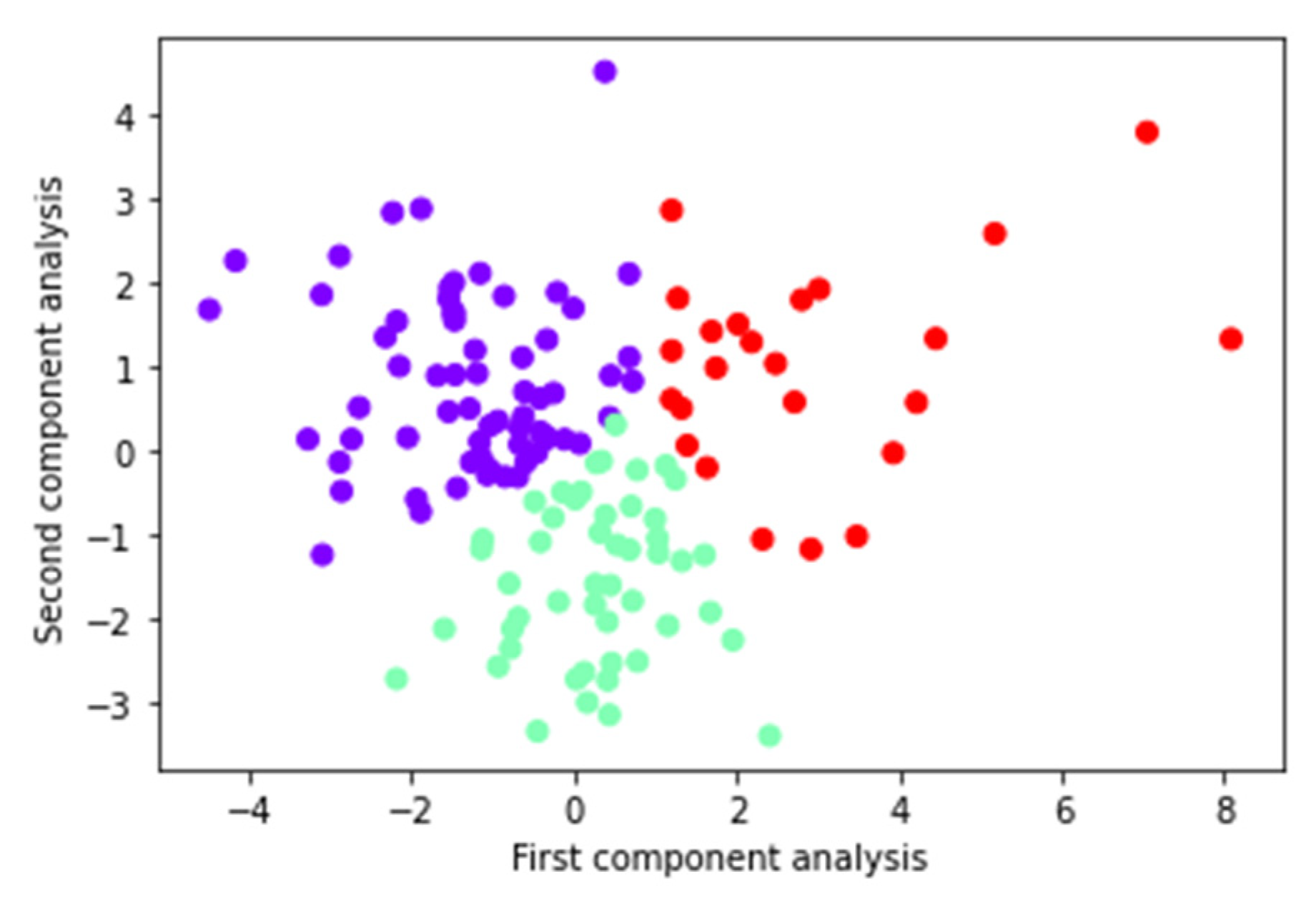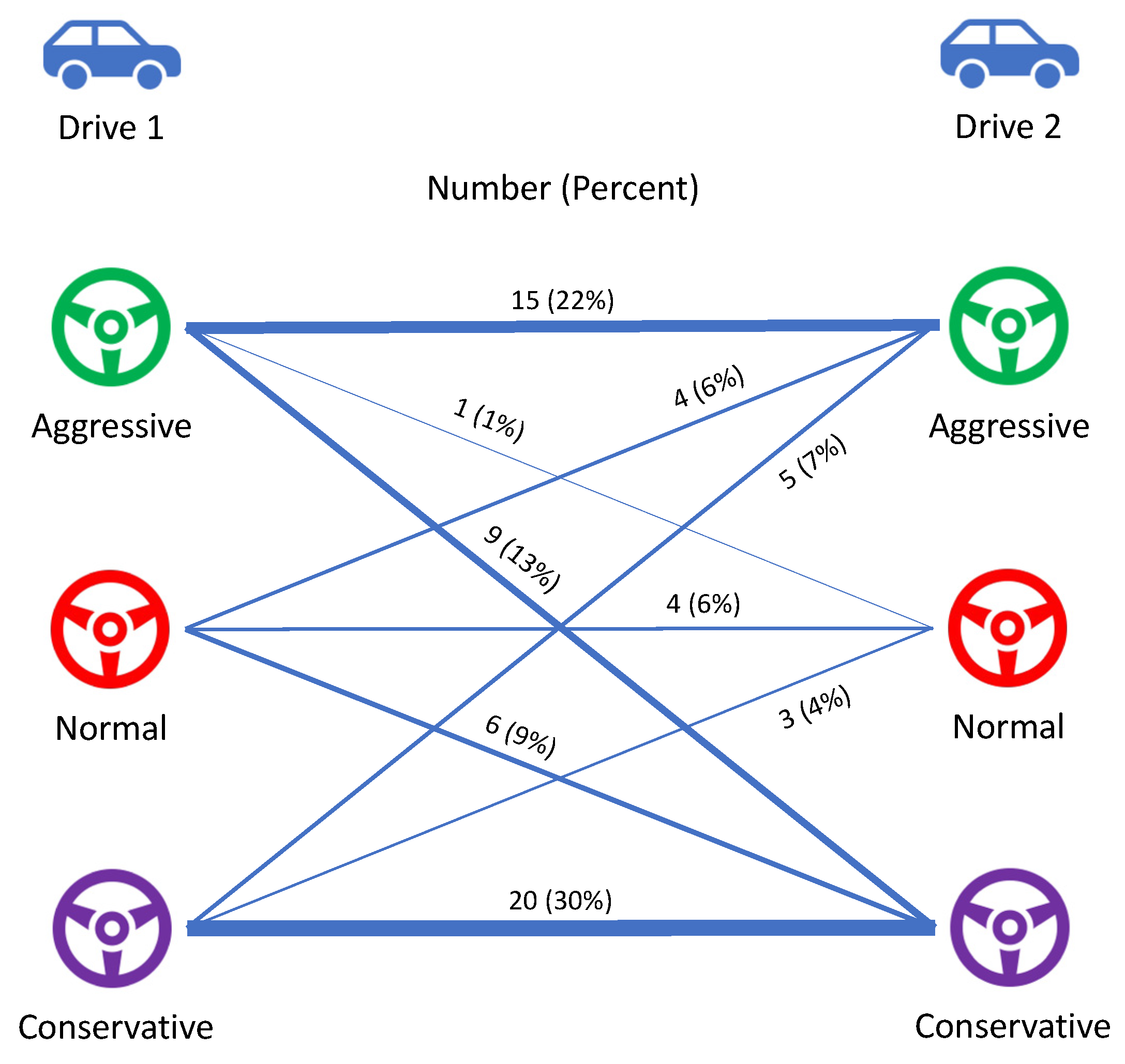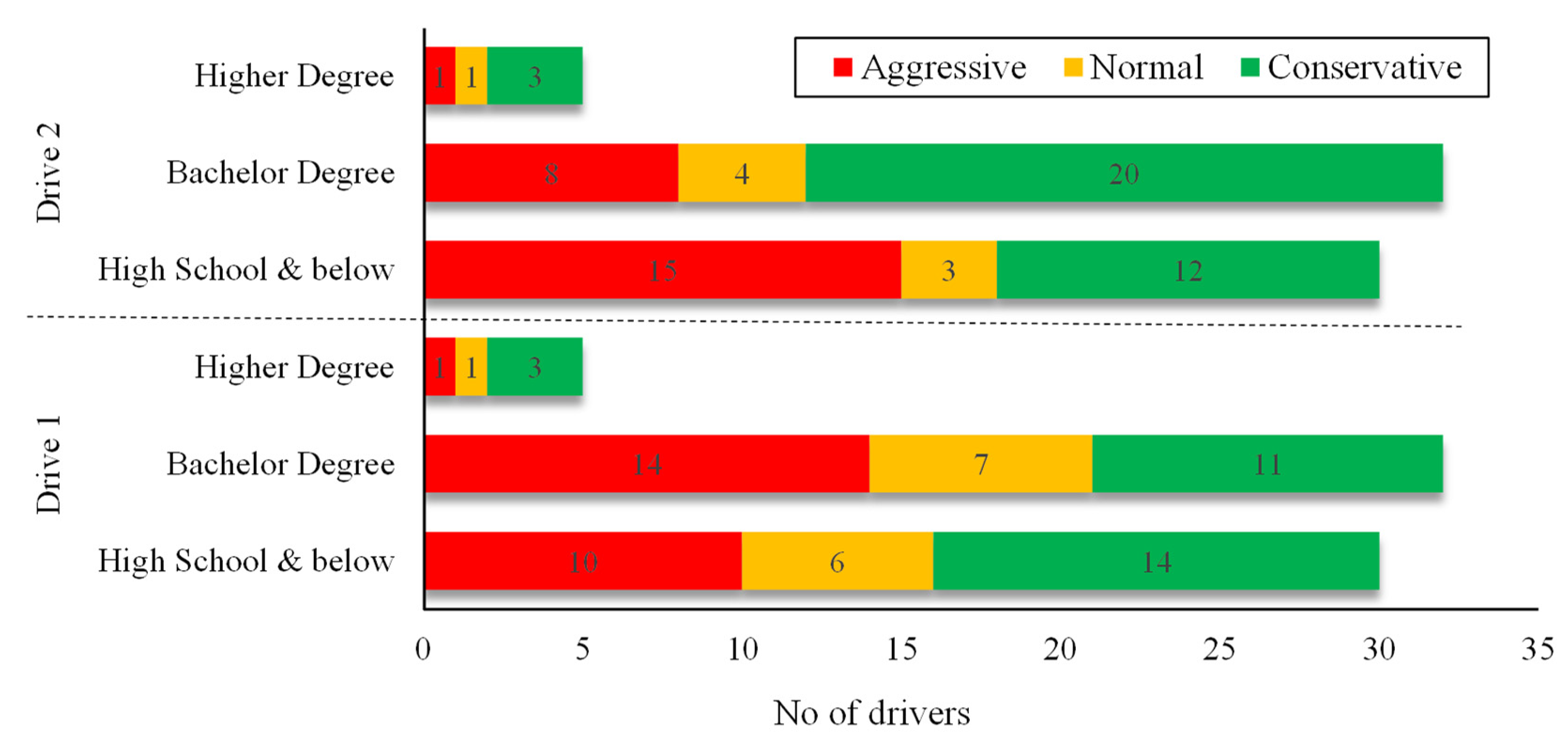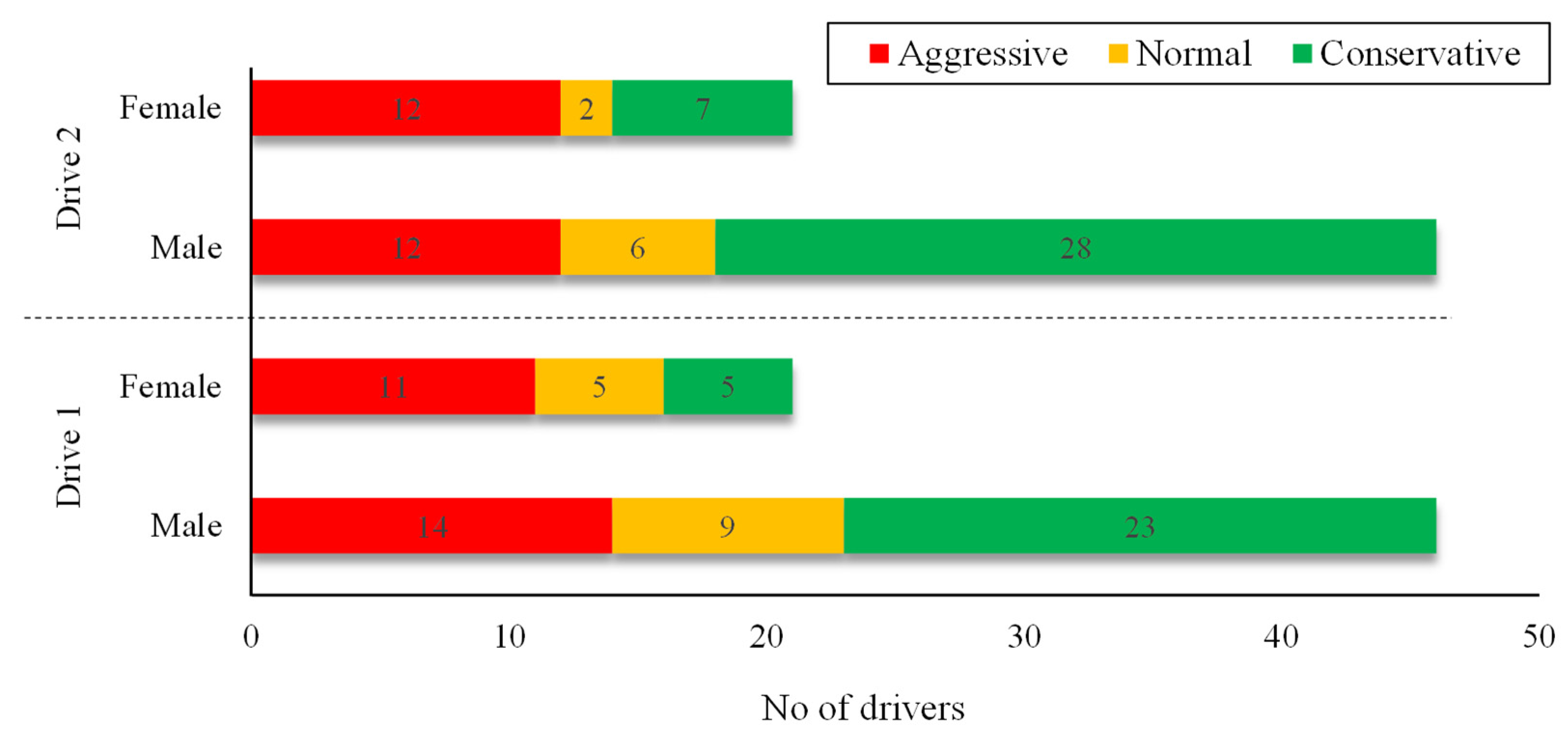Application of Unsupervised Machine Learning Classification for the Analysis of Driver Behavior in Work Zones in the State of Qatar
Abstract
1. Introduction
2. Materials and Methods
2.1. Participants
2.2. Scenarios Design
2.3. Data Collection Procedure
2.4. Framework
2.5. K-Means Algorithm
3. Analysis and Results
3.1. Clustering Results of Drive Scenarios
3.2. Analysis of Driver Characteristics
3.3. Driving Behavior Classification between Work Zones and Intersections
4. Conclusions
Author Contributions
Funding
Institutional Review Board Statement
Informed Consent Statement
Data Availability Statement
Conflicts of Interest
References
- Shahin, F.; Elias, W.; Rosenfeld, Y.; Toledo, T. An Optimization Model for Highway Work Zones Considering Safety, Mobility, and Project Cost. Sustainability 2022, 14, 1442. [Google Scholar] [CrossRef]
- Theofilatos, A.; Ziakopoulos, A.; Papadimitriou, E.; Yannis, G.; Diamandouros, K. Meta-analysis of the effect of road work zones on crash occurrence. Accid. Anal. Prev. 2017, 108, 1–8. [Google Scholar] [CrossRef] [PubMed]
- Pal, R.; Sinha, K.C. Analysis of crash rates at interstate work zones in Indiana. Transp. Res. Rec. 1996, 1529, 43–53. [Google Scholar] [CrossRef]
- Garber, N.J.; Zhao, M. Final Report Crash Characteristics at Work Zones; Rep. No. VTRC 02-R12; 2002. Available online: https://rosap.ntl.bts.gov/view/dot/20448 (accessed on 20 February 2022).
- Ashqar, H.I.; Shaheen, Q.H.Q.; Ashur, S.A.; Rakha, H.A. Impact of risk factors on work zone crashes using logistic models and Random Forest. In Proceedings of the 2021 IEEE International Intelligent Transportation Systems Conference (ITSC), Indianapolis, IN, USA, 19–22 September 2021; pp. 1815–1820. [Google Scholar]
- Almallah, M.; Hussain, Q.; Alhajyaseen, W.K.; Pirdavani, A.; Brijs, K.; Dias, C.; Brijs, T. Improved traffic safety at work zones through animation-based variable message signs. Accid. Anal. Prev. 2021, 159, 106284. [Google Scholar] [CrossRef]
- Edara, P.; Chatterjee, I. Multivariate regression for estimating driving behavior parameters in work zone simulation to replicate field capacities. Transp. Lett. 2010, 2, 175–186. [Google Scholar] [CrossRef]
- Zhang, Y.; Guo, Z.; Sun, Z. Driving Simulator Validity of Driving Behavior in Work Zones. J. Adv. Transp. 2020, 2020, 4629132. [Google Scholar] [CrossRef]
- Bharadwaj, N.; Edara, P.; Sun, C. Risk Factors in Work Zone Safety Events: A Naturalistic Driving Study Analysis. Transp. Res. Rec. J. Transp. Res. Board 2019, 2673, 379–387. [Google Scholar] [CrossRef]
- Shakouri, M.; Ikuma, L.H.; Aghazadeh, F.; Punniaraj, K.; Ishak, S. Effects of work zone configurations and traffic density on performance variables and subjective workload. Accid. Anal. Prev. 2014, 71, 166–176. [Google Scholar] [CrossRef]
- Hamdar, S.H.; Khoury, H.; Zehtabi, S. A simulator-based approach for modeling longitudinal driving behavior in construction work zones: Exploration and assessment. Simulation 2016, 92, 579–594. [Google Scholar] [CrossRef]
- Weng, J.; Meng, Q. Effects of environment, vehicle and driver characteristics on risky driving behavior at work zones. Saf. Sci. 2012, 50, 1034–1042. [Google Scholar] [CrossRef]
- Weng, J.; Meng, Q. Analysis of driver casualty risk for different work zone types. Accid. Anal. Prev. 2011, 43, 1811–1817. [Google Scholar] [CrossRef] [PubMed]
- Osman, M.; Paleti, R.; Mishra, S.; Golias, M.M. Analysis of injury severity of large truck crashes in work zones. Accid. Anal. Prev. 2016, 97, 261–273. [Google Scholar] [CrossRef] [PubMed]
- Khattak, A.J.; Khattak, A.J.; Council, F.M. Effects of work zone presence on injury and non-injury crashes. Accid. Anal. Prev. 2002, 34, 19–29. [Google Scholar] [CrossRef]
- Chitturi, M.V.; Benekohal, R. Work zone queue length and delay methodology. Transp. Lett. 2010, 2, 273–283. [Google Scholar] [CrossRef]
- Weng, J.; Meng, Q. Modeling speed-flow relationship and merging behavior in work zone merging areas. Transp. Res. Part C Emerg. Technol. 2011, 19, 985–996. [Google Scholar] [CrossRef]
- Vanlaar, W.; Simpson, H.; Mayhew, D.; Robertson, R. Aggressive driving: A survey of attitudes, opinions and behaviors. J. Saf. Res. 2008, 39, 375–381. [Google Scholar] [CrossRef]
- Miles, D.E.; Johnson, G.L. Aggressive driving behaviors: Are there psychological and attitudinal predictors. Transp. Res. Part F Traffic Psychol. Behav. 2003, 6, 147–161. [Google Scholar] [CrossRef]
- Tasca, L. A Review of the Literature on Aggressive Driving Research; Citeseer, 2000; Available online: https://www.stopandgo.org/research/aggressive/tasca.pdf (accessed on 21 February 2022).
- Shinar, D. Aggressive driving: The contribution of the drivers and the situation. Transp. Res. Part F Traffic Psychol. Behav. 1998, 1, 137–160. [Google Scholar] [CrossRef]
- Hussain, Q.; Almallah, M.; Alhajyaseen, W.K.; Dias, C. Impact of the geometric field of view on drivers’ speed perception and lateral position in driving simulators. Procedia Comput. Sci. 2020, 170, 18–25. [Google Scholar] [CrossRef]
- Hussain, Q.; Alhajyaseen, W.K.; Pirdavani, A.; Reinolsmann, N.; Brijs, K.; Brijs, T. Speed perception and actual speed in a driving simulator and real-world: A validation study. Transp. Res. Part F Traffic Psychol. Behav. 2019, 62, 637–650. [Google Scholar] [CrossRef]
- Bifulco, G.N.; Pariota, L.; Galante, F.; Fiorentino, A. Coupling instrumented vehicles and driving simulators: Opportunities from the DRIVE IN2 project. In Proceedings of the 2012 15th International IEEE Conference on Intelligent Transportation Systems, Anchorage, AK, USA, 16–19 September 2012; pp. 1815–1820. [Google Scholar]
- Brijs, T.; Mauriello, F.; Montella, A.; Galante, F.; Brijs, K.; Ross, V. Studying the effects of an advanced driver-assistance system to improve safety of cyclists overtaking. Accid. Anal. Prev. 2022, 174, 106763. [Google Scholar] [CrossRef] [PubMed]
- Bai, Y.; Li, Y. Determining the Major Causes of Highway Work Zone Accidents in Kansas; Kansas Department of Transportation: Topeka, KS, USA, 2006. [Google Scholar]
- Van Ly, M.; Martin, S.; Trivedi, M.M. Driver classification and driving style recognition using inertial sensors. In Proceedings of the 2013 IEEE Intelligent Vehicles Symposium (IV), Gold Coast, Australia, 23–26 June 2013; pp. 1040–1045. [Google Scholar]
- Constantinescu, Z.; Marinoiu, C.; Vladoiu, M. Driving style analysis using data mining techniques. Int. J. Comput. Commun. Control. 2010, 5, 654–663. [Google Scholar] [CrossRef]
- Wang, W.; Xi, J.; Chong, A.; Li, L. Driving Style Classification Using a Semisupervised Support Vector Machine. IEEE Trans. Human-Mach. Syst. 2017, 47, 650–660. [Google Scholar] [CrossRef]
- MacAdam, C.; Bareket, Z.; Fancher, P.; Ervin, R. Using neural networks to identify driving style and headway control behavior of drivers. Veh. Syst. Dyn. 1998, 29, 143–160. [Google Scholar] [CrossRef]
- Brombacher, P.; Masino, J.; Frey, M.; Gauterin, F. Driving event detection and driving style classification using artificial neural networks. In Proceedings of the 2017 IEEE International Conference on Industrial Technology (ICIT), Toronto, ON, Canada, 22–25 March 2017; pp. 997–1002. [Google Scholar] [CrossRef]
- Xie, J.; Zhu, M. Maneuver-Based Driving Behavior Classification Based on Random Forest. IEEE Sensors Lett. 2019, 3, 1–4. [Google Scholar] [CrossRef]
- Wang, W.; Xi, J. A rapid pattern-recognition method for driving styles using clustering-based support vector machines. In Proceedings of the 2016 American Control Conference (ACC), Boston, MA, USA, 6–8 July 2016; pp. 5270–5275. [Google Scholar]
- Khanfar, N.O.; Elhenawy, M.; Ashqar, H.I.; Hussain, Q.; Alhajyaseen, W.K.M. Driving behavior classification at signalized intersections using vehicle kinematics: Application of unsupervised machine learning. Int. J. Inj. Control Saf. Promot. 2022, 1–11. [Google Scholar] [CrossRef]
- Timmermans, C.; Alhajyaseen, W.; Al Mamun, A.; Wakjira, T.; Qasem, M.; Almallah, M.; Younis, H. Analysis of road traffic crashes in the State of Qatar. Int. J. Inj. Control Saf. Promot. 2019, 26, 242–250. [Google Scholar] [CrossRef]
- Toriumi, A.; Abu-Lebdeh, G.; Alhajyaseen, W.; Christie, N.; Gehlert, T.; Mehran, B.; Mussone, L.; Shawky, M.; Tang, K.; Nakamura, H. A multi-country survey for collecting and analyzing facts related to road traffic safety: Legislation, enforcement, and education for safer drivers. IATSS Res. 2022, 46, 14–25. [Google Scholar] [CrossRef]
- Kamrani, M.; Arvin, R.; Khattak, A.J. Extracting Useful Information from Basic Safety Message Data: An Empirical Study of Driving Volatility Measures and Crash Frequency at Intersections. Transp. Res. Rec. J. Transp. Res. Board 2018, 2672, 290–301. [Google Scholar] [CrossRef]
- Arvin, R.; Kamrani, M.; Khattak, A.J. The role of pre-crash driving instability in contributing to crash intensity using naturalistic driving data. Accid. Anal. Prev. 2019, 132, 105226. [Google Scholar] [CrossRef]
- Arvin, R.; Kamrani, M.; Khattak, A.J. How instantaneous driving behavior contributes to crashes at intersections: Extracting useful information from connected vehicle message data. Accid. Anal. Prev. 2019, 127, 118–133. [Google Scholar] [CrossRef] [PubMed]
- Mohammadnazar, A.; Arvin, R.; Khattak, A.J. Classifying travelers driving style using basic safety messages generated by connected vehicles: Application of unsupervised machine learning. Transp. Res. Part C Emerg. Technol. 2020, 122, 102917. [Google Scholar] [CrossRef]
- Gan, G.; Ma, C.; Wu, J. Data Clustering: Theory, Algorithms, and Applications; SIAM, 2007; Available online: https://epubs.siam.org/doi/book/10.1137/1.9780898718348 (accessed on 25 February 2022).
- Canale, M.; Malan, S. Analysis and Classification of Human Driving Behaviour in an Urban Environment. Cogn. Technol. Work 2002, 4, 197–206. [Google Scholar] [CrossRef]
- Murphey, Y.L.; Milton, R.; Kiliaris, L. Driver’s style classification using jerk analysis. In Proceedings of the 2009 IEEE Workshop on Computational Intelligence in Vehicles and Vehicular Systems, Nashville, TN, USA, 2 April 2009; pp. 23–28. [Google Scholar]
- Feng, Y.; Pickering, S.; Chappell, E.; Iravani, P.; Brace, C. Driving style analysis by classifying real-world data with support vector clustering. In Proceedings of the 2018 3rd IEEE International Conference on Intelligent Transportation Engineering (ICITE), Singapore, 3–5 September 2018; pp. 264–268. [Google Scholar]
- Li, G.; Li, S.E.; Cheng, B.; Green, P. Estimation of driving style in naturalistic highway traffic using maneuver transition probabilities. Transp. Res. Part C Emerg. Technol. 2017, 74, 113–125. [Google Scholar] [CrossRef]
- Holland, C.; Geraghty, J.; Shah, K. Differential moderating effect of locus of control on effect of driving experience in young male and female drivers. Pers. Individ. Differ. 2010, 48, 821–826. [Google Scholar] [CrossRef]
- Hennessy, D.A.; Wiesenthal, D.L. Aggression, violence, and vengeance among male and female drivers. Transp. Q. 2002, 56, 65–75. [Google Scholar]
- Hussain, Q.; Alhajyaseen, W.K.; Brijs, K.; Pirdavani, A.; Brijs, T. Innovative countermeasures for red light running prevention at signalized intersections: A driving simulator study. Accid. Anal. Prev. 2019, 134, 105349. [Google Scholar] [CrossRef]
- Li, F.; Yao, X.; Jiang, L.; Li, Y. Driving anger in China: Psychometric properties of the Driving Anger Scale (DAS) and its relationship with aggressive driving. Pers. Individ. Differ. 2014, 68, 130–135. [Google Scholar] [CrossRef]






| Volatility Measure | Description | Equation |
|---|---|---|
| Standard deviation of speed | ||
| Standard deviation of longitudinal deceleration or acceleration | ||
| Coefficient of variation of speed | ||
| Coefficient of variation of longitudinal acceleration | ||
| Coefficient of variation of longitudinal deceleration | ||
| Mean absolute deviation of speed | ||
| Mean absolute deviation of longitudinal acceleration | ||
| Quantile coefficient of variation of normalized speed | , where and are the sample 25th and 75 th percentiles. | |
| Quantile coefficient of variation of longitudinal acceleration | ||
| Quantile coefficient of variation of longitudinal deceleration |
| Cluster 1 (Conservative) | Cluster 2 (Aggressive) | Cluster 3 (Normal) | |
|---|---|---|---|
| −0.457 | 1.5604 | −0.517 | |
| −0.611 | 0.241 | 0.692 | |
| −0.408 | 1.633 | −0.257 | |
| 0.676 | −0.371 | −0.715 | |
| −0.572 | 0.04 | 0.739 | |
| −0.445 | 1.582 | −1.84 | |
| −0.355 | −0.0605 | 0.501 | |
| −0.315 | 1.243 | −0.190 | |
| 0.531 | −0.078 | −0.666 | |
| −0.151 | −0.302 | 0.349 |
Publisher’s Note: MDPI stays neutral with regard to jurisdictional claims in published maps and institutional affiliations. |
© 2022 by the authors. Licensee MDPI, Basel, Switzerland. This article is an open access article distributed under the terms and conditions of the Creative Commons Attribution (CC BY) license (https://creativecommons.org/licenses/by/4.0/).
Share and Cite
Khanfar, N.O.; Ashqar, H.I.; Elhenawy, M.; Hussain, Q.; Hasasneh, A.; Alhajyaseen, W.K.M. Application of Unsupervised Machine Learning Classification for the Analysis of Driver Behavior in Work Zones in the State of Qatar. Sustainability 2022, 14, 15184. https://doi.org/10.3390/su142215184
Khanfar NO, Ashqar HI, Elhenawy M, Hussain Q, Hasasneh A, Alhajyaseen WKM. Application of Unsupervised Machine Learning Classification for the Analysis of Driver Behavior in Work Zones in the State of Qatar. Sustainability. 2022; 14(22):15184. https://doi.org/10.3390/su142215184
Chicago/Turabian StyleKhanfar, Nour O., Huthaifa I. Ashqar, Mohammed Elhenawy, Qinaat Hussain, Ahmad Hasasneh, and Wael K. M. Alhajyaseen. 2022. "Application of Unsupervised Machine Learning Classification for the Analysis of Driver Behavior in Work Zones in the State of Qatar" Sustainability 14, no. 22: 15184. https://doi.org/10.3390/su142215184
APA StyleKhanfar, N. O., Ashqar, H. I., Elhenawy, M., Hussain, Q., Hasasneh, A., & Alhajyaseen, W. K. M. (2022). Application of Unsupervised Machine Learning Classification for the Analysis of Driver Behavior in Work Zones in the State of Qatar. Sustainability, 14(22), 15184. https://doi.org/10.3390/su142215184










